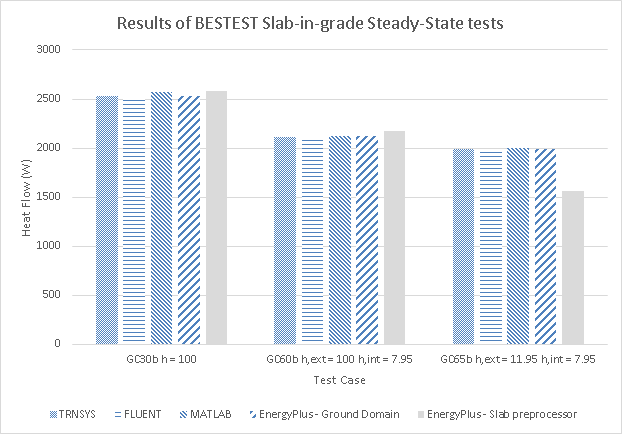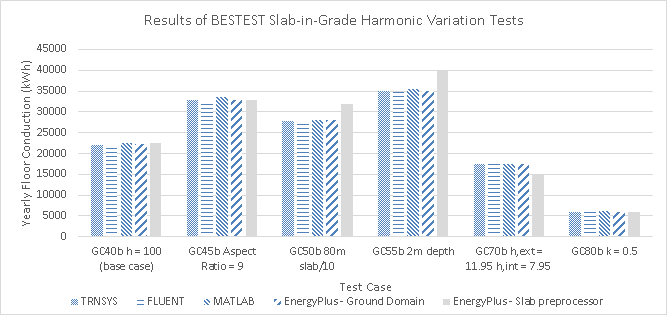First time here? Check out the Help page!
 | 1 | initial version |
There are currently no published studies comparing the models, however, there is a masters thesis coming out this summer that compares the models. Once that is out, we will work on getting some other peer-reviewed studies published.
Here is some preliminary data from the unpublished masters thesis comparing the slab preprocessor method against the ground-coupled method for a Chicago location. Under ideal conditions with no variations in zone conditions (no windows, constant zone temp), the models perform similarly. But when windows are added, the slab method overestimates heating loads by 18% and underestimates cooling loads by 21% compared to the coupled model.
For a house with no windows but with a floating zone temperature, the floor heat flow predictions are 15% lower with the Slab preprocessor method.


As of right now we are seeing good comparisons between different tools. There are some differences in results between the preprocessor method and the groud-coupled groundDomain method, which we believe are expected due the differences in the methods.
I would have to look into whether we have seen larger temperature swings with the ground-coupled method. I'm not aware of it as of right now. Regarding the effort spend on improving the preprocessor method, I'm not sure I'm aware of that either, but maybe we're thinking of two separate things. In the original post you cite here there is reference to improving the preprocessors, but the ground-coupled method is separate from them so that reference is not correct. There may have been other workflow improvements but I don't think they relate specifically to the preprocessors.
I'm not expecting there to be any additional work on the preprocessors. Once these models start getting some use and people are comfortable with them, the preprocessors will likely go away. Or at least make them to be downloaded separately. Hopefully I'm not overstepping my bounds by saying that.
One disclaimer: from this testing work, there were a few recommended modifications to the code which will make their way into the next E+ release. They are currently sitting on a branch waiting to be merged in. Let me know if you want a version with those changes incorporated. (I think thats OK, unless someone on the EPDT tells me otherwise). Let me know if you have any other questions.
 | 2 | Suggested edit |
There are currently no published studies comparing the models, however, there is a masters thesis coming out this summer that compares the models. Once that is out, we will work on getting some other peer-reviewed studies published.
Here is some preliminary data from the unpublished masters thesis comparing the slab preprocessor method against the ground-coupled method for a Chicago location. Under ideal conditions with no variations in zone conditions (no windows, constant zone temp), the models perform similarly. But when windows are added, the slab method overestimates heating loads by 18% and underestimates cooling loads by 21% compared to the coupled model.
For a house with no windows but with a floating zone temperature, the floor heat flow predictions are 15% lower with the Slab preprocessor method.


As of right now we are seeing good comparisons between different tools. There are some differences in results between the preprocessor method and the groud-coupled groundDomain method, which we believe are expected due the differences in the methods.
I would have to look into whether we have seen larger temperature swings with the ground-coupled method. I'm not aware of it as of right now. Regarding the effort spend on improving the preprocessor method, I'm not sure I'm aware of that either, but maybe we're thinking of two separate things. In the original post you cite here there is reference to improving the preprocessors, but the ground-coupled method is separate from them so that reference is not correct. There may have been other workflow improvements but I don't think they relate specifically to the preprocessors.
I'm not expecting there to be any additional work on the preprocessors. Once these models start getting some use and people are comfortable with them, the preprocessors will likely go away. Or at least make them to be downloaded separately. Hopefully I'm not overstepping my bounds by saying that.separately.
One disclaimer: from this testing work, there were a few recommended modifications to the code which will make their way into the next E+ release. They are currently sitting on a branch waiting to be merged in. Let me know if you want a version with those changes incorporated. (I think thats OK, unless someone on the EPDT tells me otherwise). Let me know if you have any other questions.
Edit: This version would only be appropriate testing purposes due to lack of transition support.
